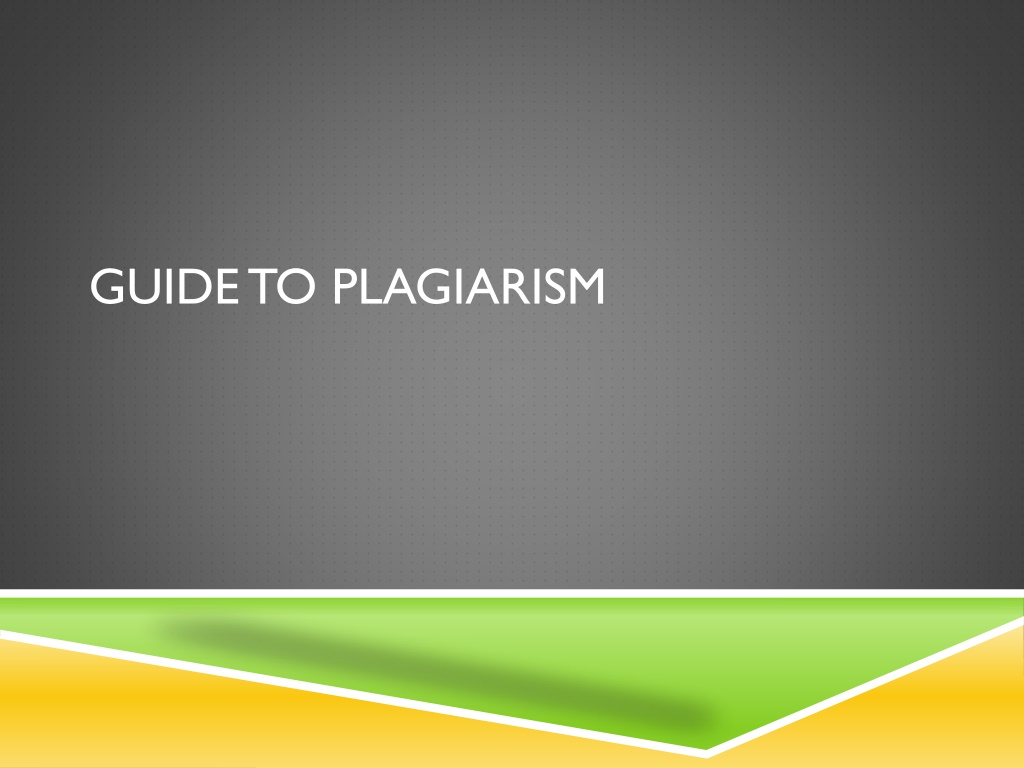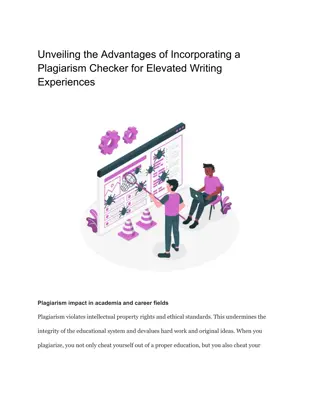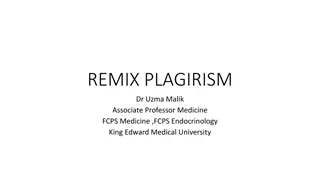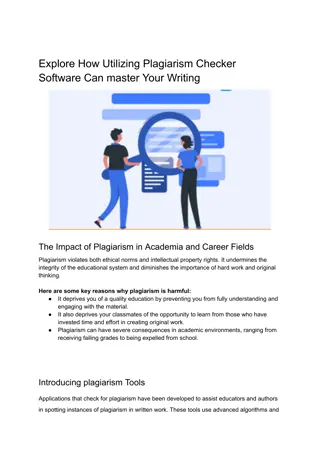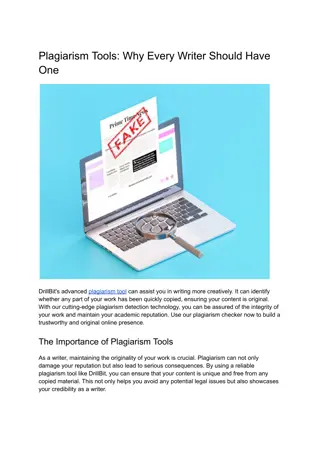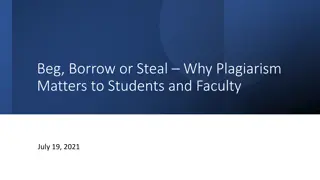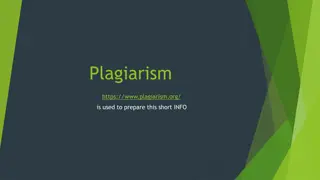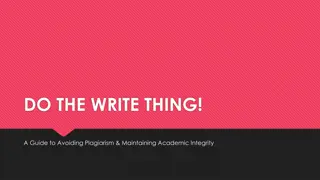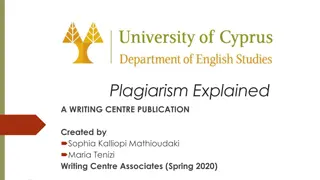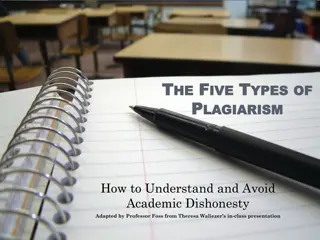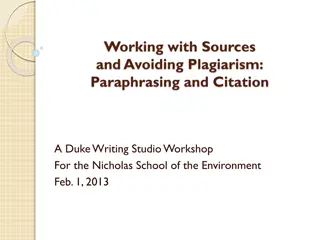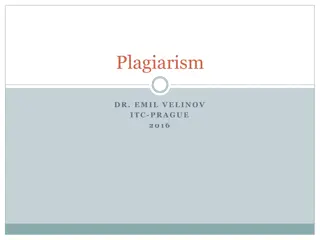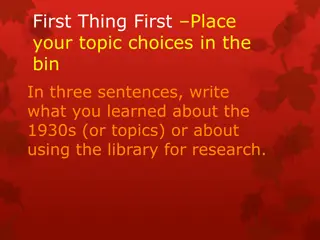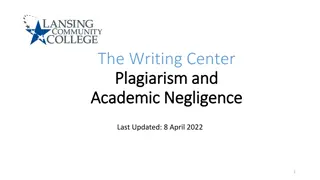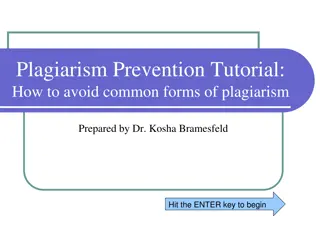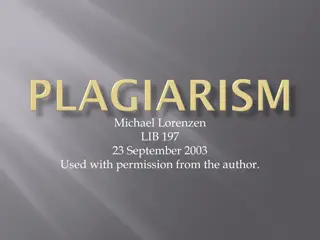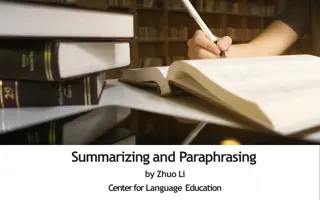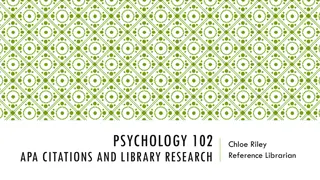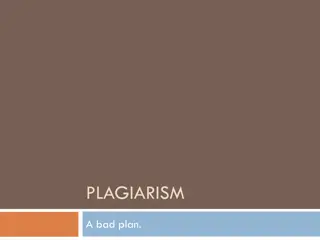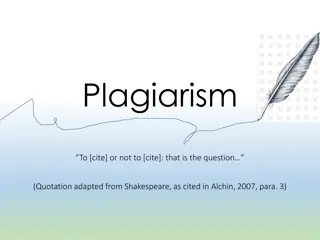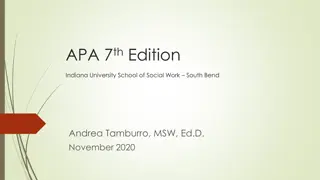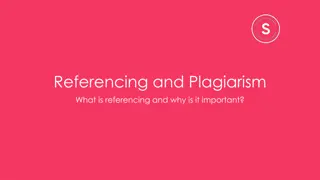Understanding Plagiarism: Types, Consequences, and How to Avoid It
Explore the comprehensive guide on plagiarism covering its definition, types, consequences, and prevention strategies. The content delves into self-plagiarism and offers tips to steer clear of academic misconduct. Learn about policies, quizzes, and common misconceptions regarding plagiarism.
Download Presentation

Please find below an Image/Link to download the presentation.
The content on the website is provided AS IS for your information and personal use only. It may not be sold, licensed, or shared on other websites without obtaining consent from the author. Download presentation by click this link. If you encounter any issues during the download, it is possible that the publisher has removed the file from their server.
E N D
Presentation Transcript
OVERVIEW What is plagiarism? Quiz Types of plagiarism. Consequences of plagiarism. How to avoid plagiarism. Questions?
DEFINING PLAGIARISM Basic Definition Merriman-Webster (2012), defines plagiarism as to steal and pass of (the ideas or words of another) as one s own: use (another s production) without crediting sources (para. 1). Source: Merriman-Webster, 2012
DEFINING PLAGIARISM Wayne State University has policies in place for plagiarism We refer students to Wayne State University s Academic Integrity Policy: http://doso.wayne.edu/student-conduct/Academic_Integrity.html
STUDENTS MAY ARGUE... Question: Identify the statements which may be considered plagiarism: 1. I am just using a few pages from a paper I wrote last semester . 2. I did the research, I should be able to resubmit whatever I want . 3. If it is a topic I am passionate about, I should be able to use portions of my old work . 4. I will just change a few sentences around but use the same references . 5. My spouse/child/parent/colleague wrote/rewrote sections of the paper I felt were not detailed enough...it s not plagiarized, is it? Answer: All of the above may be considered plagiarism by a professor and are subject to the same policies in place for traditional acts of plagiarism.
SELF-PLAGIARISM Yes, it is real. Yes, it is a problem on campus. Using a portion or entire body of previously submitted work may be considered self-plagiarism. Portions of previously submitted work may be caught by scanning software like SafeAssign or by a professor. Suggestions to students include seeking out new topics to broaden prospective and avoid the temptation of using previously submitted work. Suggestions to students who are passionate about their topic of interest include meeting with their professor and discussing it before going forward.
SELF-PLAGIARISM The APA Manual also contains information on self-plagiarism: The American Psychological Association (APA) 6th Edition Manual (2009), states Just as researchers do not present the work of others as their own (plagiarism), they do not present their own previously published work as new. . . (p. 16). Additional coverage of self-plagiarism continues in Chapter 6 of the APA Style Manual. Avoid charges of self-plagiarism by familiarizing yourself with the ethical standards regarding duplicate publication and the legal standards of fair use (Publication Manual, 2009, p. 170).
OTHER TYPES OF PLAGIARISM Intentional plagiarism, which includes: Directly copying another s work and not crediting the original author. Directly copying paragraphs, sentences, or phrases and not crediting the original author. This is also known as cut and paste plagiarism and patchwork plagiarism. Unintentional plagiarism, which includes: Paraphrasing or summarizing another s work and not crediting the original author. Quoting, paraphrasing, or summarizing another s work and incorrectly citing the original author An example may be using a direct quotation, citing correctly but not utilizing quotation marks.
HOW TO AVOID PLAGIARISM Cite Properly BSW and MSW students should own the 6th Edition Publication Manual from the American Psychological Association (APA) in their library. This book is available at all campus bookstores. Students must place quotation marks around everything that comes directly from the text. Students must check paraphrasing by not rearranging or replacing a few words. Proper paraphrasing is an interpretation of the author s ideas in one s own words. Workshops are offered regularly that cover paraphrasing specifically. All mandated students receive a workshop on paraphrasing, as part of their APA Style workshop.
HOW TO AVOID PLAGIARISM Cite Properly Know When to Cite: Quoting Paraphrasing Summarizing
HOW TO AVOID PLAGIARISM Use the Writing Center. Many students do not realize they have FREE writing assistance on campus. Students should make an effort to utilize the free services available to them. The Writing Center, located inside the Undergraduate Library. (313) 577-2544 The School of Social Work has writing tutors. Contact them via email or phone. Understand Wayne State University Policy. http://doso.wayne.edu/student-conduct/Academic_Integrity.html Still unsure? Students are encouraged to see their advisor or professor for more information about plagiarism. Students have endless FREE resources available to them.
RESOURCES Wayne State University Student Code of Conduct: http://www.doso.wayne.edu/codeofconduct.pdf Wayne State Univeristy s Office of Teaching and Learning: http://www.otl.wayne.edu/wsu_integrity.php The American Psychological Association: http://www.apastyle.org Plagiarism dot org plagiarism.org Purdy-Kresge Library http://www.lib.wayne.edu
CONTACT US! If you have further questions regarding plagiarism, please schedule an appointment with your witting tutor!
